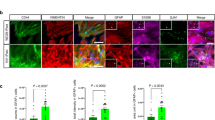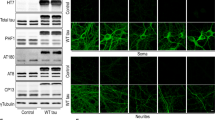Abstract
Parkinson’s disease (PD) is a neurodegenerative disorder characterized by the loss of dopaminergic neurons. LncRNA small nucleolar RNA host gene 14 (SNHG14) was found to promote neuron injury in PD. Here, we investigated the mechanisms of SNHG14 in PD process. In vivo or in vitro PD model was established by using 1-methyl-4-phenyl-1,2,3,6-tetrahydropyridine (MPTP)-induced mice or 1-methyl-4-phenylpyridinium (MPP +)-stimulated SK-N-SH cells. The expression of genes and proteins was measured by qRT-PCR and Western blot. In vitro assays were conducted using ELISA, CCK-8, colony formation, EdU, flow cytometry, and Western blot assays, respectively. The oxidative stress was evaluated by determining the production of superoxide dismutase (SOD) and malondialdehyde (MDA). The direct interactions between miR-375-3p and NFAT5 (Nuclear factor of activated T-cells 5) or SNHG14 was verified using dual-luciferase reporter and RNA immunoprecipitation (RIP) assays. SNHG14 and NFAT5 were elevated, while miR-375-3p was decreased in MPTP-mediated PD mouse model and MPP + -induced SK-N-SH cells. Knockdown of SNHG14 or NFAT5, or overexpression of miR-375-3p reversed MPP + -induced neuronal apoptosis, inflammation, and oxidative stress. Mechanistically, SNHG14 directly bound to miR-375, which targeted NFAT5. Inhibition of miR-375-3p abolished the inhibitory activity of SNHG14 knockdown on MPP + -evoked neuronal damage. Besides that, NFAT5 up-regulation counteracted the effects of miR-375-3p on MPP + -mediated neuronal damage. SNHG14 contributed to MPP + -induced neuronal injury by miR-375/NFAT5 axis, suggesting a new insight into the pathogenesis of PD.
Graphical Abstract
MPP + elevated SNHG14, which then increased NFAT5 by sequestering miR-375, thereby contributing to MPP + -induced inflammation, apoptosis, oxidative stress, and arrest of proliferation in neurons.









Similar content being viewed by others
Data Availability
The analyzed data sets generated during the present study are available from the corresponding author on reasonable request.
References
Kalia LV, Lang AE (2015) Parkinson’s disease. Lancet (London, England) 386(9996):896–912
Abou-Sleiman PM, Muqit MM, Wood NW (2006) Expanding insights of mitochondrial dysfunction in Parkinson’s disease. Nat Rev Neurosci 7(3):207–219
Zhou C, Huang Y, Przedborski S (2008) Oxidative stress in Parkinson’s disease: a mechanism of pathogenic and therapeutic significance. Ann N Y Acad Sci 1147:93–104
Michel PP, Hirsch EC, Hunot S (2016) Understanding dopaminergic cell death pathways in Parkinson disease. Neuron 90(4):675–691
Lu B, Gehrke S, Wu Z (2014) RNA metabolism in the pathogenesis of Parkinson׳s disease. Brain Res 1584:105–115
Geisler S, Coller J (2013) RNA in unexpected places: long non-coding RNA functions in diverse cellular contexts. Nat Rev Mol Cell Biol 14(11):699–712
Cabili MN, Trapnell C, Goff L, Koziol M, Tazon-Vega B, Regev A, Rinn JL (2011) Integrative annotation of human large intergenic noncoding RNAs reveals global properties and specific subclasses. Genes Dev 25(18):1915–1927
Riva P, Ratti A, Venturin M (2016) The long non-coding RNAs in neurodegenerative diseases: novel mechanisms of pathogenesis. Curr Alzheimer Res 13(11):1219–1231
Zhang Y, Xia Q, Lin J (2020) LncRNA H19 attenuates apoptosis in MPTP-induced parkinson’s disease through regulating miR-585-3p/PIK3R3. Neurochem Res 45(7):1700–1710
Zhao J, Li H, Chang N (2020) LncRNA HOTAIR promotes MPP+-induced neuronal injury in Parkinson’s disease by regulating the miR-874-5p/ATG10 axis. EXCLI J 19:1141–1153
Ye T, Zhang N, Wu W, Yang B, Wang J, Huang W, Tang D (2019) SNHG14 promotes the tumorigenesis and metastasis of colorectal cancer through miR-32-5p/SKIL axis. In Vitro Cell Dev Biol Anim 55(10):812–820
Xie SD, Qin C, Jin LD, Wang QC, Shen J, Zhou JC, Chen YX, Huang AH, Zhao WH, Wang LB (2020) Long noncoding RNA SNHG14 promotes breast cancer cell proliferation and invasion via sponging miR-193a-3p. Eur Rev Med Pharmacol Sci 24(14):7543
Li L, Zhang R, Li SJ (2020) Long noncoding RNA SNHG14 promotes ovarian cancer cell proliferation and metastasis via sponging miR-219a-5p. Eur Rev Med Pharmacol Sci 24(14):7541
Zhang LM, Wang MH, Yang HC, Tian T, Sun GF, Ji YF, Hu WT, Liu X, Wang JP, Lu H (2019) Dopaminergic neuron injury in Parkinson’s disease is mitigated by interfering lncRNA SNHG14 expression to regulate the miR-133b/ α-synuclein pathway. Aging 11(21):9264–9279
Zhou S, Zhang D, Guo J, Zhang J, Chen Y (2020) Knockdown of SNHG14 alleviates MPP(+)-induced injury in the cell model of Parkinson’s disease by targeting the miR-214-3p/KLF4 axis. Front Neurosci 14:930
Zhuang Z, Zhang L, Liu C (2022) SNHG14 Upregulation was a molecular mechanism underlying MPP(+) neurotoxicity in dopaminergic SK-N-SH cells via SNHG14-miR-519a-3p-ATG10 ceRNA pathway. Neurotox Res 40(2):553–563
Yuan X, Wu Y, Lu L, Feng J (2022) Long noncoding RNA SNHG14 knockdown exerts a neuroprotective role in MPP(+)-induced Parkinson’s disease cell model through mediating miR-135b-5p/KPNA4 axis. Metab Brain Dis 37(7):2363–2373
Di Monte DA: Mitochondrial DNA and Parkinson's disease. Neurology 1991, 41(5 Suppl 2):38–42; discussion 42–33
Lotankar S, Prabhavalkar KS, Bhatt LK (2017) Biomarkers for Parkinson’s disease: recent advancement. Neurosci Bull 33(5):585–597
Dexter DT, Jenner P (2013) Parkinson disease: from pathology to molecular disease mechanisms. Free Radical Biol Med 62:132–144
Salta E, De Strooper B (2012) Non-coding RNAs with essential roles in neurodegenerative disorders. The Lancet Neurology 11(2):189–200
Chen S, Wang J (2019) HAND2-AS1 inhibits invasion and metastasis of cervical cancer cells via microRNA-330-5p-mediated LDOC1. Cancer Cell Int 19:353
Chen J, Lin Y, Jia Y, Xu T, Wu F, Jin Y (2019) LncRNA HAND2-AS1 exerts anti-oncogenic effects on ovarian cancer via restoration of BCL2L11 as a sponge of microRNA-340-5p. J Cell Physiol 234(12):23421–23436
Luo Q, Wei C, Li X, Li J, Chen L, Huang Y, Song H, Li D, Fang L (2014) MicroRNA-195-5p is a potential diagnostic and therapeutic target for breast cancer. Oncol Rep 31(3):1096–1102
Pozniak T, Shcharbin D, Bryszewska M (2022) Circulating microRNAs in Medicine. Int J Mol Sci 23(7):3996
Saliminejad K, Khorram Khorshid HR, Soleymani Fard S, Ghaffari SH (2019) An overview of microRNAs: biology, functions, therapeutics, and analysis methods. J Cell Physiol 234(5):5451–5465
Goh SY, Chao YX, Dheen ST, Tan EK, Tay SS (2019) Role of MicroRNAs in Parkinson’s disease. Int J Mol Sci 20(22):5649
Cai LJ, Tu L, Li T, Yang XL, Ren YP, Gu R, Zhang Q, Yao H, Qu X, Wang Q et al (2020) Up-regulation of microRNA-375 ameliorates the damage of dopaminergic neurons, reduces oxidative stress and inflammation in Parkinson’s disease by inhibiting SP1. Aging 12(1):672–689
Miyakawa H, Woo SK, Dahl SC, Handler JS, Kwon HM (1999) Tonicity-responsive enhancer binding protein, a rel-like protein that stimulates transcription in response to hypertonicity. Proc Natl Acad Sci USA 96(5):2538–2542
Lee N, Kim D, Kim WU (2019) Role of NFAT5 in the immune system and pathogenesis of autoimmune diseases. Front Immunol 10:270
Yang XL, Wang X, Peng BW (2018) NFAT5 has a job in the brain. Dev Neurosci 40(4):289–300
Wang R, Li Q, He Y, Yang Y, Ma Q, Li C (2020) miR-29c-3p inhibits microglial NLRP3 inflammasome activation by targeting NFAT5 in Parkinson’s disease. Genes Cells: Devoted Mol Cell Mech 25(6):364–374
Acknowledgements
None.
Funding
None.
Author information
Authors and Affiliations
Contributions
NB and XL designed and performed the research, FX wrote the manuscript. All authors read and approved the final manuscript.
Corresponding author
Ethics declarations
Conflict of interest
The authors declare that they have no conflicts of interest.
Research Involving Human and Animal Rights
All animal experiments were approved by the Institutional Animal Care and Use Committee of the Chengdu Seventh People's Hospital (Approval No. 2020115S).
Consent for Publication
Written informed consents were obtained from all participants.
Additional information
Publisher's Note
Springer Nature remains neutral with regard to jurisdictional claims in published maps and institutional affiliations.
Supplementary Information
Below is the link to the electronic supplementary material.
11064_2024_4106_MOESM1_ESM.tif
Supplementary file1 (TIF 41 KB)—The viability of SK-N-SH cells treated with MPP+ (0, 0.5, 1, and 2 mM) for 24 h. one-way ANOVA, n=3.
11064_2024_4106_MOESM2_ESM.tif
Supplementary file2 (TIF 50 KB)—qRT-PCR analysis for SNHG14 expression in the subcellular fractions of MPP+ treated SK-N-SH cells. n=3.
Rights and permissions
Springer Nature or its licensor (e.g. a society or other partner) holds exclusive rights to this article under a publishing agreement with the author(s) or other rightsholder(s); author self-archiving of the accepted manuscript version of this article is solely governed by the terms of such publishing agreement and applicable law.
About this article
Cite this article
Xu, F., Bian, N. & Li, X. SNHG14 Elevates NFAT5 Expression Through Sequestering miR-375-3p to Promote MPP + -Induced Neuronal Apoptosis, Inflammation, and Oxidative Stress in Parkinson’s Disease. Neurochem Res 49, 1212–1225 (2024). https://doi.org/10.1007/s11064-024-04106-y
Received:
Revised:
Accepted:
Published:
Issue Date:
DOI: https://doi.org/10.1007/s11064-024-04106-y




